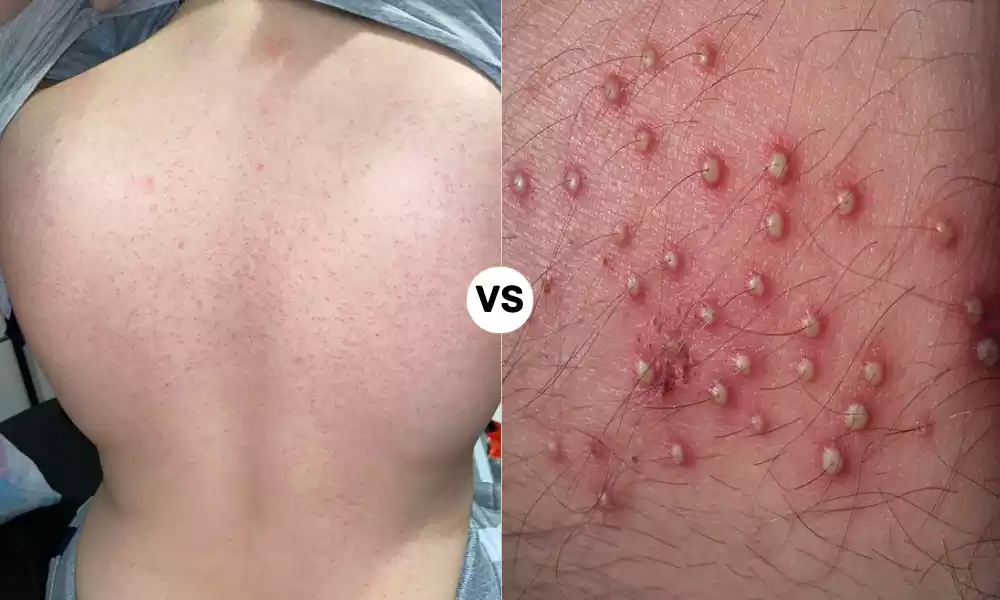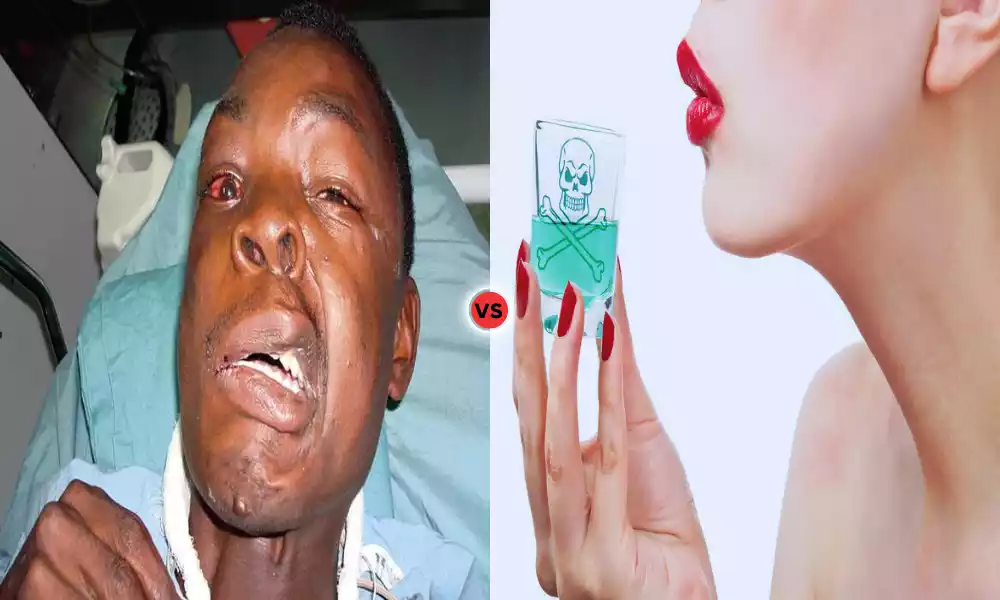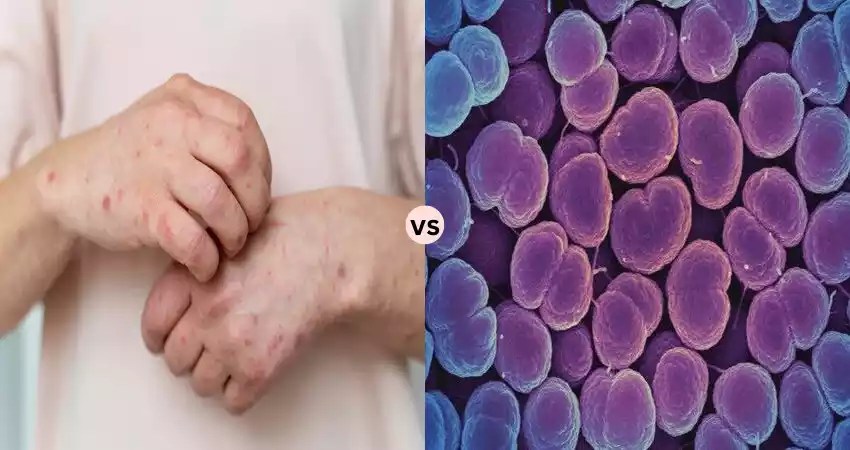Keratosis Pilaris and Folliculitis are two distinct skin conditions that manifest as small bumps on the skin. KP is characterized by tiny, rough bumps often described as “chicken skin,” resulting from the buildup of keratin, a protein that blocks hair follicles. Commonly appearing on the upper arms, thighs, and buttocks, it’s largely driven by genetic factors and keratin overproduction.
On the other hand, Folliculitis is an inflammation or infection of the hair follicles. This condition can be caused by bacteria, fungi, viruses, or skin irritation, leading to red, inflamed, or pus-filled bumps primarily centered around hair follicles. It can manifest anywhere on the body where hair is present, including the face, neck, and scalp. While both conditions involve hair follicles, their causes, appearance, and treatments differ significantly.
What is Keratosis Pilaris?
Keratosis Pilaris (KP) is a common, benign skin condition characterized by the formation of small, rough, pimple-like bumps on the skin. These bumps are caused by an overproduction of keratin, a protein that can block hair follicles. The condition is often referred to as “chicken skin” due to its sandpaper-like texture. Although it can appear anywhere on the body, it’s most commonly found on the upper arms, thighs, cheeks, and buttocks. While KP is harmless and usually doesn’t cause pain or itching, many individuals seek treatment for cosmetic reasons.

Causes and Risk Factors of Keratosis Pilaris
1. Excessive Keratin Production: At the root of KP is the overproduction of keratin, a protein that protects the skin from harmful substances and infections. This excess keratin can block hair follicles, leading to the tiny bumps characteristic of KP.
2. Genetic Predisposition:
- KP tends to run in families, suggesting a genetic link.
- Those with a family history of KP are more likely to develop the condition themselves.
3. Dry Skin:
- People with dry skin are more prone to developing KP, as dryness can exacerbate the rough texture and appearance of the bumps.
- The condition often worsens in colder months or in low-humidity environments where the skin is more likely to become dry.
4. Other Skin Conditions:
- Individuals with certain skin conditions, such as atopic dermatitis (eczema) or ichthyosis vulgaris, are at a higher risk of having KP.
5. Age:
- While KP can affect people of all ages, it’s more common in children and adolescents.
- Many people notice a decrease in symptoms as they age, with the condition sometimes disappearing entirely in adulthood.
6. Hormonal Changes:
- Some individuals experience a worsening of KP symptoms during periods of hormonal fluctuation, such as pregnancy.
While the exact cause of KP remains not fully understood, a combination of genetic factors and environmental triggers likely plays a role in its development. Regular moisturizing and proper skincare can help manage and reduce the appearance of KP, although its presence is entirely benign and poses no health risks.
Symptoms and Presentation of Keratosis Pilaris (KP)
1. Small Bumps:
- KP is primarily characterized by tiny, painless bumps on the skin. These can be either red or white and are often described as having a sandpaper-like texture.
2. Common Locations:
- KP frequently appears on the upper arms, thighs, and buttocks.
- In children, it can also present on the cheeks.
3. Dry and Rough Patches:
- Areas affected by KP often feel rough to the touch.
- The skin may appear drier in these areas compared to surrounding skin.
4. Mild Redness:
- The skin around the bumps can sometimes be slightly red, giving a reddish or inflamed appearance to patches of KP.
5. Absence of Pain or Itching:
- Unlike many skin conditions, KP is generally not painful.
- Some individuals may experience mild itching, especially when the skin is particularly dry or during flare-ups.
6. Worsening in Certain Conditions:
- Symptoms can intensify during colder months or in environments with low humidity, both of which can exacerbate skin dryness.
- Some individuals also report flare-ups during times of hormonal changes, such as pregnancy.
7. Persistence:
- KP is chronic, meaning it’s long-lasting. While it often appears in childhood or adolescence, it can persist into adulthood. However, for many, the severity decreases with age.
Keratosis Pilaris presents as small, rough bumps in specific areas like the arms and thighs. The condition is cosmetic, often causing no physical discomfort, and is mainly a concern for individuals due to its appearance.
Treatment and Management of Keratosis Pilaris
Treatment and Management of Keratosis Pilaris (KP)
While there’s no cure for KP, several strategies can help manage its appearance and improve skin texture:
1. Moisturizing:
- Regular application of moisturizers can help hydrate the skin, softening keratin buildup and reducing the rough texture of KP.
- Products containing urea or lactic acid can be especially effective, as they not only moisturize but also exfoliate the skin.
2. Topical Exfoliants:
- Over-the-counter creams containing alpha hydroxy acids (AHAs), such as glycolic or lactic acid, can help to exfoliate the skin and remove dead skin cells.
- Beta hydroxy acids (BHAs) like salicylic acid can also be effective, particularly as they can penetrate oil and exfoliate inside the hair follicle.
3. Topical Retinoids:
- Products containing ingredients like tretinoin or adapalene promote cell turnover and can be beneficial in treating KP. However, they may cause irritation in some individuals and are often available by prescription.
4. Physical Exfoliation:
- Gently using a body scrub or exfoliating brush can help remove keratin buildup. It’s essential to be gentle to avoid further irritation.
5. Laser Therapy:
- Pulsed dye laser (PDL) treatments can reduce the redness associated with KP.
- Some individuals may also benefit from intense pulsed light (IPL) treatments.
6. Avoiding Skin Dryness:
- Taking short, lukewarm showers instead of long hot ones can prevent further skin dryness.
- Applying moisturizer immediately after showering can help lock in moisture.
7. Sun Protection:
- Although not a direct treatment for KP, using sunscreen can help prevent any hyperpigmented spots from darkening.
8. Prescription Medications:
- In more severe or persistent cases, a dermatologist may prescribe stronger creams or ointments.
While Keratosis Pilaris is benign and often doesn’t require medical treatment, the options listed above can significantly improve its appearance. It’s advisable to consult with a dermatologist or skincare professional to determine the most suitable treatment plan based on individual needs.
What is Folliculitis?
Folliculitis is an inflammation or infection of the hair follicles, the small pouches from which hair grows. This condition results in the appearance of small, red, inflamed bumps or pustules, often centered around a hair follicle. Folliculitis can be caused by various factors, including bacterial, fungal, or viral infections, physical irritation, or blocked hair follicles. It can manifest on any part of the body that has hair, such as the face, scalp, chest, back, or legs.
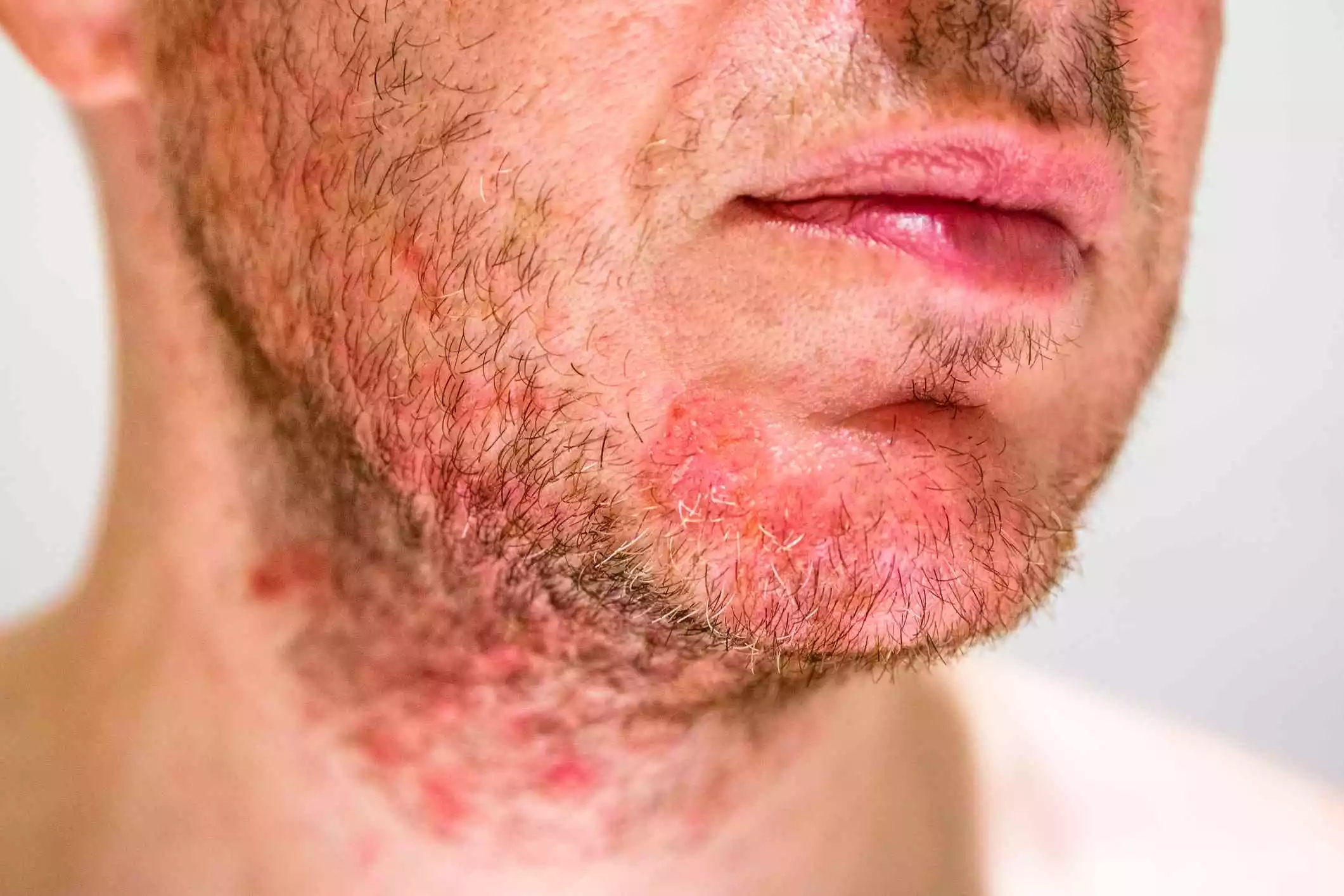
Causes and Risk Factors of Folliculitis
Causes and Risk Factors of Folliculitis
Causes:
1. Bacterial Infection:
- The most common cause is the Staphylococcus aureus bacteria.
- This bacterium resides on the skin of many individuals without causing harm but can trigger folliculitis if it enters deeper into the hair follicles.
2. Fungal Infection:
- Folliculitis can be caused by various fungi. The yeast-like fungus called Pityrosporum is one such common culprit, especially on the face and upper body.
3. Viral Infection:
- Viruses such as herpes simplex or molluscum contagiosum can also cause folliculitis.
4. Inflammatory Reactions:
- Certain substances, including oils, cosmetics, and creams, can block follicles, leading to an inflammatory reaction mimicking folliculitis.
5. Physical Irritation:
- Friction from tight clothing, frequent shaving, or abrasive skin treatments can irritate the hair follicles and lead to folliculitis.
- Razor bumps (pseudofolliculitis barbae) are a type of folliculitis caused by ingrown hairs from shaving.
6. Other Causes:
- Hot tub use can result in a specific type known as “hot tub folliculitis,” caused by the bacterium Pseudomonas aeruginosa.
Risk Factors:
1. Skin Trauma:
- Any injury to the skin, such as from shaving or wearing tight clothing, increases the risk of folliculitis.
2. Pre-existing Skin Conditions:
- Conditions like dermatitis, acne, or eczema can make the skin more susceptible.
3. Impaired Immune System:
- Conditions such as HIV/AIDS, diabetes, chronic leukemia, or undergoing treatments like chemotherapy can make individuals more vulnerable to infections, including folliculitis.
4. Topical Corticosteroids:
- Prolonged use of these medications can weaken the skin’s natural defense mechanisms.
5. Exposure to Infected Water:
- Using poorly maintained hot tubs or swimming in pools with imbalanced pH can increase the risk.
6. Obstructive Skin Conditions:
- Conditions that cause excessive sweating, like obesity or hyperhidrosis, can pave the way for folliculitis.
While folliculitis can be caused by various pathogens, several risk factors can predispose individuals to develop the condition. Identifying the root cause and understanding associated risk factors is crucial for appropriate treatment and prevention.
Symptoms and Presentation of Folliculitis
Symptoms and Presentation of Folliculitis
Folliculitis manifests in several characteristic ways, depending on its severity and cause. Here are the typical symptoms and presentations:
Red or Pink Bumps:
- The most common sign is the presence of small, red or pinkish bumps around hair follicles. These bumps can sometimes resemble acne.
2. Pus-filled Blisters:
- The bumps may evolve into white-headed pimples or pustules filled with pus.
3. Itchy or Burning Sensation:
- Affected areas can be itchy or cause a burning sensation, especially if they’re inflamed.
4. Tenderness or Pain:
- The lesions or areas around them may become tender or painful to touch, especially in cases of deep or severe folliculitis.
5. Swelling:
- Swelling or inflammation around the affected hair follicles can occur, particularly in more aggressive infections.
6. Crusty Sores:
- In some cases, after the pus-filled blisters break open, they can crust over, forming yellowish sores.
7. Hair Loss:
- In chronic or severe cases of folliculitis, it can lead to hair loss in the affected area.
8. Scarring:
- Persistent or recurrent folliculitis can result in scarring or hyperpigmentation in the affected areas.
9. Recurrence:
- Certain types of folliculitis may recur frequently, causing repeated outbreaks in the same or different areas.
10. Other Associated Symptoms:
- In the case of more severe or widespread infections, individuals may experience additional symptoms like fever or fatigue, although these are less common.
Differentiating between mild, superficial folliculitis and its more severe, deeper form is crucial. The superficial type usually affects the upper part of the hair follicle, while the deeper type (also known as sycosis barbae) impacts the entire follicle and can be more severe.
Treatment and Management of Folliculitis
Treatment and Management of Folliculitis
The treatment of folliculitis largely depends on its cause, severity, and location. Here’s an overview of common treatments and management strategies:
1. Antibacterial Treatments:
- Topical Antibiotics: For mild cases caused by bacteria, creams or gels containing antibiotics like clindamycin or mupirocin may be prescribed.
- Oral Antibiotics: More widespread or deeper infections may require oral antibiotics such as cephalexin, dicloxacillin, or tetracycline.
2. Antifungal Treatments:
- Topical Antifungals: Creams, shampoos, or washes with active ingredients like ketoconazole or ciclopirox are effective for fungal folliculitis.
- Oral Antifungals: In persistent or severe fungal cases, oral antifungals like fluconazole or itraconazole may be recommended.
3. Antiviral Treatments:
- In cases caused by viruses (e.g., herpes simplex), antiviral medications like acyclovir can be effective.
4. Steroid Creams or Pills:
- These can help reduce inflammation, especially in non-infectious folliculitis. However, they should be used judiciously and typically for short periods due to potential side effects.
5. Laser Hair Removal:
- For those prone to chronic folliculitis, especially from ingrown hairs (like pseudofolliculitis barbae), laser hair removal can reduce the frequency of outbreaks by targeting the hair follicle.
6. Proper Skin Hygiene:
- Keeping the skin clean with gentle, non-irritating cleansers can prevent potential flare-ups.
- For individuals prone to “hot tub folliculitis,” ensuring the appropriate maintenance and chlorination of hot tubs is crucial.
7. Avoiding Tight Clothing:
- This minimizes friction and reduces the risk of physical irritation to hair follicles.
8. Warm Compress:
- Applying a warm, moist cloth to affected areas can soothe the skin, promote drainage, and speed healing.
9. Over-the-counter Treatments:
- Products containing benzoyl peroxide can be helpful for mild cases.
- Hydrocortisone cream can help alleviate itching and inflammation.
10. Avoiding Shaving:
- If shaving exacerbates folliculitis, it might be helpful to take a break or use an electric razor, which doesn’t cut as closely.
11. Drainage of Large Boils or Carbuncles:
- If folliculitis progresses to large, painful lumps (boils or carbuncles), they might need to be drained surgically. This should be done by a healthcare professional.
If someone suspects they have folliculitis, it’s important to see a dermatologist or primary care physician to confirm the diagnosis and get appropriate treatment recommendations. Self-diagnosis and treatment can sometimes exacerbate the condition or lead to complications.
Comparison table of Keratosis Pilaris and Folliculitis
Here’s a comparison table contrasting Keratosis Pilaris (KP) and Folliculitis:
| Feature | Keratosis Pilaris | Folliculitis |
|---|---|---|
| Definition | A benign skin condition where tiny bumps form due to excess keratin at the base of hair follicles. | Inflammation of hair follicles, usually due to an infection or irritation. |
| Cause | Overproduction of keratin. Not caused by an infection. | Usually caused by bacterial (commonly Staphylococcus aureus), fungal, or viral infections. Can also be due to physical irritation. |
| Appearance | Tiny, rough, painless bumps. Can be red or white. | Red, inflamed bumps, often with a pus-filled head. Can resemble acne. |
| Location | Commonly on upper arms, thighs, and buttocks. | Can occur anywhere on the body where hair follicles are present. |
| Symptoms | Mainly cosmetic concern. Rarely itchy. | Can be itchy, painful, and cause a burning sensation. |
| Complications | Generally no complications; however, can cause self-consciousness or minor itching. | Can lead to scarring, abscesses, recurrent infections, and post-inflammatory hyperpigmentation. |
| Treatment | Emphasis on moisturizing and exfoliating. Topical retinoids can also help. | Depends on cause. Can include antibiotics, antifungals, antivirals, and other measures to reduce infection and inflammation. |
| Prevention | Regular moisturizing, avoiding skin dryness. | Good skin hygiene, avoiding irritants, and in some cases, preventative antibiotics. |
| Duration & Persistence | Chronic condition; tends to persist long-term but can improve with age. | Duration varies. Can be acute or chronic, depending on the cause and response to treatment. |
While this table provides a clear comparison, the conditions can sometimes be misdiagnosed or mistaken for one another. A dermatological consultation is the best approach for accurate diagnosis and management.
What are the similarities between Keratosis Pilaris and Folliculitis?
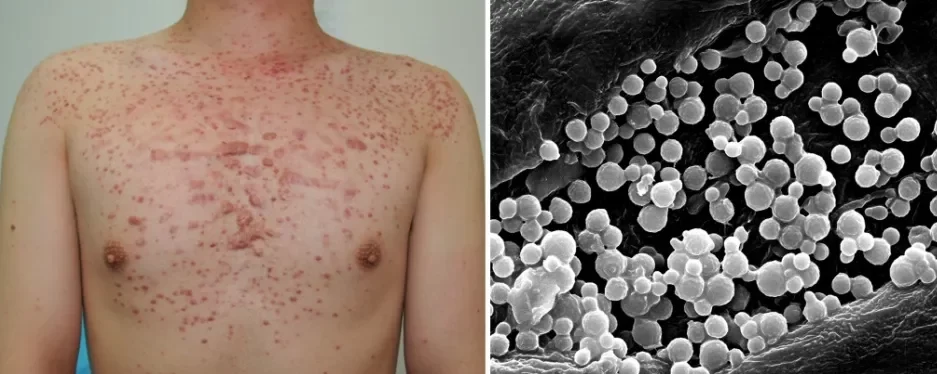
Keratosis Pilaris (KP) and Folliculitis, despite their distinct nature, share several similarities:
- Hair Follicle Involvement: Both conditions involve the hair follicles. In KP, excess keratin blocks the hair follicles, while in folliculitis, these follicles become inflamed or infected.
- Appearance: Both can manifest as small, raised bumps on the skin. This similar presentation can sometimes lead to confusion or misdiagnosis.
- Common Body Locations: While KP typically appears on the upper arms, thighs, and buttocks, and folliculitis can occur anywhere with hair follicles, both conditions frequently affect areas where there is friction or where the skin rubs against clothing.
- Potential for Itching: Both conditions can be itchy, though this symptom is more consistently associated with folliculitis.
- Chronic Nature: Both KP and folliculitis can have chronic presentations. While KP is inherently a long-term condition, some forms of folliculitis can recur over long periods.
- Management with Topicals: Topical treatments play a role in managing both conditions. KP often benefits from moisturizers and exfoliants, while topical antibiotics or antifungals can be used for folliculitis.
- Cosmetic Concern: Many individuals seek treatment for both conditions primarily due to cosmetic concerns, as the skin’s appearance can affect self-esteem.
- Potential for Misdiagnosis: Due to their similar appearance, especially in mild cases, they can be mistaken for one another or for other skin conditions.
Recognizing these similarities is essential, but it’s equally crucial to understand their differences, especially when determining an appropriate treatment approach.
Conclusion
Keratosis Pilaris (KP) and Folliculitis, while both involving hair follicles, are distinct skin conditions with different causes, presentations, and treatments. KP is a benign condition characterized by small, rough bumps due to keratin overproduction, mainly found on areas like the upper arms and thighs. It’s primarily a cosmetic concern with treatments focused on moisturization and exfoliation.
Folliculitis, on the other hand, is an inflammation of the hair follicles, often caused by bacterial, fungal, or viral infections. It presents as red, sometimes pus-filled bumps and can be itchy or painful. Treatment for folliculitis aims to address the underlying infection or irritation. Although both conditions can affect one’s self-esteem, they are typically manageable with proper care and consultation from a dermatologist.

